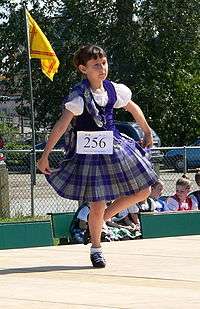Aboyne dress


The Aboyne dress is the name given to the prescribed attire for female dancers in the Scottish national dances, such as the Flora MacDonald, the Highland lilt, and others. There are actually two versions of the Aboyne dress in use.
Description
In one version, a tartan pattern skirt is worn with an over-the-shoulder plaid, a white blouse and petticoat, and a velvet bodice. The alternative is a white dress over a petticoat, together with a tartan pattern sash. A typical Aboyne dress consists of a dark bodice or elaborate waistcoat, decorative blouse, full tartan skirt and some times a petticoat and apron. Some have a tartan sash (usually draped over the shoulder and coming down towards the hem of the skirt in the back) rather than an apron.[1] While appearing to be simple and plain (and poorly assembled), a properly made, modern Aboyne dress might and can be quite expensive.
History
The name derives from the Aboyne Highland Gathering[2] in Scotland where, in the 1970s the dance committee, dissatisfied with the state of affairs of female Highland dance attire, prescribed new rules governing acceptable and better-looking attire for the female dancers. The problem, as they saw it, was that many felt that the female and male dancers should not be wearing the same outfits and that a separate style for women should be developed. The men would continue to dance in kilt and jacket, wearing bonnets and sporrans.
The original decision of the Aboyne committee applied to both the Highland dances and the National dances. This was modified by the Scottish Official Board of Highland Dancing (SOBHD) a few years later so that the Aboyne dress would be used by women for just the national dances with a different, kilt-based outfit (though with no bonnet or sporran for females) for the Highland dances. To this day, however, the wearing of the kilt by women is strictly forbidden at the Aboyne Gathering except for when performing two specific dances, the Pas de Basques and the Pas de Basques and Highcuts.
See also
- Scotland portal
Notes
- ↑ http://www.margshighlanddancewear.com/aboyne.htm
- ↑ "The Traditional Highland Games – Since 1867". aboynegames.com.
External links
-
 The dictionary definition of Aboyne dress at Wiktionary
The dictionary definition of Aboyne dress at Wiktionary - Scottish Official Board of Highland Dancing
| ||||||||||||||||||||||||||||||||||||||||||||||||||||||||||||||||||